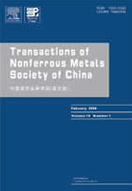Low-temperature pressureless consolidation of AlSi10Mg powders by low-intensity ultrasound
(1. School of Physical Science and Technology, Northwestern Polytechnical University, Xi’an 710100, China;
2. Herbert Gleiter Institute of Nanoscience, School of Materials Science and Engineering, Nanjing University of Science and Technology, Nanjing 210094, China;
3. State Key Laboratory of Solidification Processing, Northwestern Polytechnical University, Xi’an 710072, China)
2. Herbert Gleiter Institute of Nanoscience, School of Materials Science and Engineering, Nanjing University of Science and Technology, Nanjing 210094, China;
3. State Key Laboratory of Solidification Processing, Northwestern Polytechnical University, Xi’an 710072, China)
Abstract: Low-intensity ultrasound was applied to the pressureless consolidation of AlSi10Mg powders in a broad temperature range from 600 to 860 °C. Under static conditions, the consolidation of AlSi10Mg powders can only be achieved at 860 °C, but still with the presence of some residual unconsolidated regions. The introduction of low-intensity ultrasound at this temperature eliminates the unconsolidated regions and transforms the columnar grains observed in original directional solidification into equiaxed or globular grains. Remarkably, the application of low-intensity ultrasound significantly reduces the consolidation temperature to 620 °C, without compromising the microhardness of the resulting samples when compared to static conditions. Furthermore, by lowering the temperature to 600 °C, a well-sintered porous material is obtained through the assistance of the low-intensity ultrasound.
Key words: low-intensity ultrasound; pressureless consolidation; aluminum powders; columnar-to-equiaxed transition; microhardness

